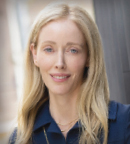
Amanda Eilian
I have many of the risk factors for melanoma. I’m fair-skinned, blue-eyed, and have a family history of melanoma, as well as other skin cancers, so I’ve always been diligent about practicing sun safety and maintaining annual full-body skin exams to catch any suspicious moles or lesions that could potentially be malignant. That is why it is so frustrating that despite my best efforts, in 2010, I was diagnosed with stage II melanoma, a diagnosis I believe could have been prevented.
For 2 years, during my yearly skin exam, I would point out an odd-looking dark spot on my right wrist to my dermatologist, who each time shrugged off my concern with a matter-of-fact, “No, it’s fine. Don’t worry about it.” But, the following year, a comment from my then 2-year-old daughter as I was getting ready to leave for my next skin exam, convinced me I had to have the lesion removed.
“Mommy, chocolate, Mommy, chocolate,” my daughter said as she pointed to the spot on my wrist. Her reaction and the fact that my regular dermatologist was running late to the appointment, necessitating a switch to another physician for the exam, gave me the courage to insist the lesion be removed, even as he, too, assured me I had nothing to worry about.
Getting the News No One Wants to Hear
Within days of the exam, I received a voicemail message from my dermatologist with an apology. “Amanda, I’m sorry. I was wrong,” he said. “This is actually melanoma, and you need to come back to my office immediately for further testing.”
A pathology report from a follow-up punch biopsy of the malignancy found that I most likely had stage II melanoma. Even though a physician I had consulted for a second opinion said I probably qualified for a lymph node biopsy to determine whether the cancer had spread to distant sites, it was not recommended. Fortunately, I found a surgeon who was able to successfully remove the tumor with clear margins and preserve the mobility in my right hand.
Regaining Control
Still, the diagnosis and its aftermath left me reeling. Despite my risk factors for the cancer, I never really thought such a life-threatening disease could happen to me.
I was just 32 when I was diagnosed with melanoma. When you’re young, you feel invincible, but the reality of the diagnosis destabilized me in many ways, and I was scared. I had recently had a baby, and thinking about her and her 2-year-old sister and what having this cancer could mean for them caused a lot of anxiety. I felt so vulnerable and out of control. To regain some control, I leaned into lifestyle interventions to boost my immune system, including meditation, diet, and exercise, to, hopefully, reduce my risk for recurrence, which helped.
Getting this diagnosis also propelled me to refocus my career and how I spend my time. I cofounded Able Partners, a New York City–based venture capital fund aimed at lifestyle and well-being, to help others become proactive in their health care. I also became involved in the Melanoma Research Alliance (MRA; curemelanoma.org) soon after my diagnosis and joined the board of directors 4 years later.
I am so impressed with the rapid pace of drug discoveries in targeted therapies and immunotherapies for this cancer, which are extending 5-year survival outcomes for about 50% of patients with metastatic disease,1 my husband, Jonathan, and I have helped fund an MRA Team Science Award, as well as two Young Investigator Awards. Making a contribution to this incredible research is gratifying and gives me hope, not just for me but for other melanoma survivors as well, that we will eventually convert this once nearly always fatal disease into a chronic or even curable one.
Being Part of the Solution
Because of the high rate of recurrence in melanoma, even after nearly 15 years since my diagnosis, I see a dermatologist every 3 months to ensure the cancer hasn’t recurred and to check for any new skin cancers. Although I’m thrilled to say I have been cancer-free since my initial treatment, the anxiety that the cancer will eventually come back is always with me.
Prior to my diagnosis, going to the doctor never sparked any concern. Now, I recognize my good health is not something I can take for granted, and none of us is guaranteed an illness-free future.
I now have four children and know they are at higher risk of developing melanoma, so everyone in our family is conscientious about following sun-safety practices and getting regular skin checks.
I’m so grateful to the founders of the Melanoma Research Alliance and to all the scientists doing such incredible research in this still very serious cancer. Their work is enabling survivors like me to experience durable remissions and even cures.
Certainly, there is still more to be accomplished in melanoma research. But I’m encouraged by the incredible progress I see every day in more effective treatments for this cancer and in the number of lives saved. I will continue to do my part to support this important research, so more survivors like me can live long, cancer-free lives.
REFERENCE
1. Steininger J, Gellrich FF, Schulz A, et al: Systemic therapy of metastatic melanoma: On the road to cure. Cancers (Basel) 13:1430, 2021.
Ms. Eilian, 46, lives in New York City. She is the cofounder of Able Partners and a board member of the Melanoma Research Alliance.
Editor’s Note: Columns in the Patient’s Corner are based solely on information The ASCO Post received from patients and should be considered anecdotal.

